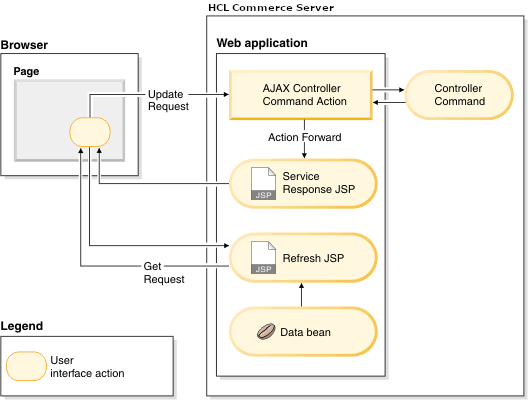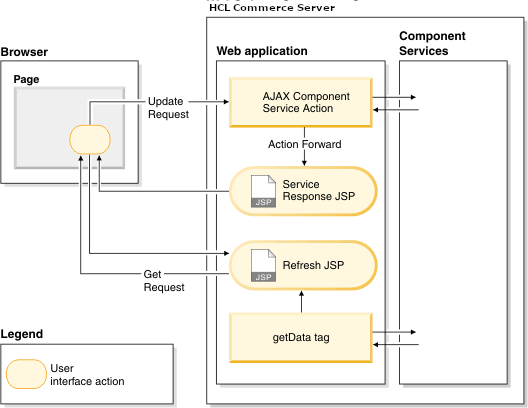HCL Commerce AJAX framework
The HCL Commerce AJAX framework is an extension of the jQuery AJAX framework. It provides an easy to use framework that meets most AJAX requirements for storefront development, and hides some of the complexity and repetitive code that a storefront developer often encounters.
There are four common scenarios that are involved with the HCL Commerce AJAX framework:
- An AJAX call is made to the Transaction server to update a business object. Sections of the page are refreshed with new content if the update is successful. The new content is retrieved by using subsequent AJAX calls to the Transaction server.
- An AJAX call is made to refresh a section of the page because of certain customer interactions.
- An AJAX call is made to the Transaction server to update a business object.
Sections of the page must refresh with new content if the update is successful. The new content is
retrieved by using subsequent AJAX calls to the Transaction server. The process is the
same as the first scenario, however, instead of making the code modular, a less traffic intensive
approach to the server is required.
In this scenario, an AJAX call is made to the HCL Commerce server to update a business object. Sections of the page are refreshed with new content if the update is successful. All the relevant information to refresh the contents of the page are returned as a JSON object. The client then has the contents of the JSON object. The client uses the DOM manipulation API to modify all the areas of the page that must change as a result of the successful update.
- An AJAX call is made to the Transaction server and JSON data is requested. Sections of the page are then updated by using JavaScript and the DOM manipulation API.
The HCL Commerce AJAX framework is not required for the third and fourth scenarios, as these scenarios can be performed directly by using the jQuery AJAX API.
You can make concurrent Ajax calls for views.
Scenario 1: Updating a business object in HCL Commerce using AJAX, then refreshing multiple areas by using subsequent AJAX requests to get the refresh contents
- An AJAX call is made to an HCL Commerce controller command or HCL Commerce service to update a business object (or multiple business objects).
- Subsequent AJAX get requests are made to HCL Commerce views to retrieve the new HTML contents for each area if the update is successful.
Interaction diagram when you call HCL Commerce controller commands:

Interaction diagram when you call HCL Commerce services:

1. Making an AJAX call to an HCL Commerce controller command or service
Before the client is able to call an HCL Commerce controller command or service by using AJAX, the Transaction server must define that the controller command or service can be called by using AJAX (rather than the traditional programming model where the request is made and a new redirect is implied by the HCL Commerce run time).
To define a controller command or service to be available for AJAX type requests, simply define a new struts-action entry in the struts-config XML file that identifies the controller command or service as an AJAX type of action. For example, to create a new struts-action for the InterestItemAdd controller command that can be called by using AJAX, it must be defined it in the struts configuration XML file:
<action
parameter="com.ibm.commerce.interestitems.commands.InterestItemAddCmd"
path="/AjaxInterestItemAdd"
type="com.ibm.commerce.struts.AjaxAction">
<set-property property="authenticate" value="0:0"/>
<set-property property="https" value="0:1"/>
</action>
<action class="com.ibm.commerce.struts.v2.AjaxAction" name="AjaxInterestItemAdd">
<param name="authenticate">0:0</param>
<param name="https">0:1</param>
<param name="parameter">com.ibm.commerce.interestitems.commands.InterestItemAddCmd</param>
</action><action
parameter="order.addOrderItem"
path="/AjaxOrderChangeServiceItemAdd" type="com.ibm.commerce.struts.AjaxComponentServiceAction">
<set-property property="authenticate" value="0:0"/>
<set-property property="https" value="0:1"/>
</action>
<action class="com.ibm.commerce.struts.v2.AjaxComponentServiceAction" name="AjaxOrderChangeServiceItemAdd">
<param name="authenticate">0:0</param>
<param name="https">0:1</param>
<param name="parameter">order.addOrderItem</param>
</action>- WC_eardir/Stores.war/AjaxActionResponse.jsp (success case)
- WC_eardir/Stores.war/AjaxActionErrorResponse.jsp (failure case)
 workspace_dir/Stores/WebContent/AjaxActionResponse.jsp
workspace_dir/Stores/WebContent/AjaxActionResponse.jsp workspace_dir/Stores/WebContent/AjaxActionErrorResponse.jsp
workspace_dir/Stores/WebContent/AjaxActionErrorResponse.jsp
wcService.declare({
id: "AjaxInterestItemAdd",
actionId: " AjaxInterestItemAdd",
url: " AjaxInterestItemAdd",
formId: "",
successHandler: function(serviceResponse) {
alert("success");
},
failureHandler: function(serviceResponse) {
if (serviceResponse.errorMessage) {
alert(serviceResponse.errorMessage);
}
}
});
wcService.invoke("AjaxInterestItemAdd");
2. Making AJAX calls to HCL Commerce views to get refresh contents
<div wcType="RefreshArea"
id="WishlistSelect_Widget"
declareFunction="declareRefreshArea()"
refreshurl="<c:out value="${WishListSelectAreaView}"/>">
</div>
refreshurl attribute
defines the Transaction server URL to call and get the new HTML contents for the refresh area that
the refresh controller is associated to. The refresh controllers are automatically registered to
listen to modelChanged and renderContextChanged events. Therefore, they are notified when these
events occur. They then evaluate the model changes and/or render context changes and decide whether
the refresh areas that it manages must be refreshed or not. The following sample code shows how to
define a refresh
controller:
function declareRefreshArea () {
var myWidgetObj = $("#WishlistSelect_Widget")
var myRCProperties = wcRenderContext.getRenderContextProperties("WishlistSelect_Context");
var renderContextChangedHandler = function() {
};
// model change
wcTopic.subscribe(order_updated, function() {
myWidgetObj.refreshWidget("refresh", myRCProperties);
});
// post refresh handler
var postRefreshHandler = function() {
};
// initialize widget with properties
$("#"+divId).refreshWidget({
renderContextChangedHandler: renderContextChangedHandler,
postRefreshHandler: postRefreshHandler
});
}
Scenario 2: Refreshing an area of the page by using an AJAX request to get the refresh contents
Areas of the page must refresh with new content when users interact with the user interface. This scenario uses the render context, refresh area and refresh controllers API from the HCL Commerce AJAX framework.
A render context object keeps track of context information of the client and it can trigger renderContextChanged events whenever updates occur to any of the properties in the render context object. The refresh controllers are automatically registered to listen to all the renderContextChanged events. The refresh controller logic determines whether the context change must trigger an update of a refresh area widget. Therefore, in the refresh controller's renderContextChangedHandler, the API is used to compare the context properties testForChangedRC to determine whether the context property is changed and then trigger the refresh of the refresh area.
Scenario 3: Updating a business object in HCL Commerce using AJAX and returning all relevant update information by using JSON
var parameters = {};
parameters.storeId = storeId;
parameters.langId=langId;
parameters.catalogId=catalogId;
parameters.catentryId=productId;
parameters.URL="MiniCartContentsJSON";
parameters.errorViewName="MiniCartContentsJSON";
$.ajax({
url: "OrderChangeServiceItemAdd",
method: "post",
dataType: "json",
data: parameters,
success: refreshMiniCart,
error: function(jqXHR,textStatus, err) {
}
});
The load function uses the JSON object and DOM manipulation API to replace all the elements in the page that must be updated with new data that resulted from the server update. URLs do not need to be registered as AjaxAction, as this scenario does not use any of the new HCL Commerce AJAX frameworks.
Scenario 4: Calling Transaction server by using AJAX to gather new data as a JSON object and refreshing the page contents
This scenario can be achieved by using the jQuery API directly. Therefore, there is no need to use the HCL Commerce AJAX framework if this scenario is of relevant interest. The jQuery API is used with the traditional HCL Commerce runtime programming model, where a request is made to a view that maps to a JSP file that creates a JSON object. On the load function of the AJAX API, the DOM manipulation API is used to put the JSON contents in the web page elements.